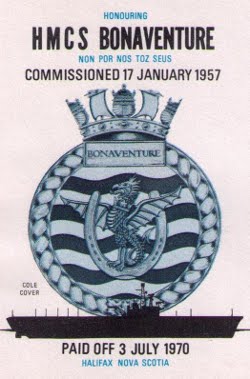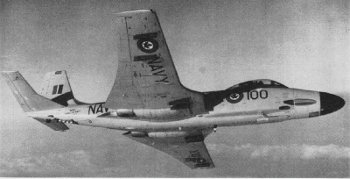Topic: RCN

Bonaventure Commissioning
First Canadian-Owned Carrier is Up-To-Date

Ottawa Citizen, 21 January 1957
The commissioning of Her Majesty's Canadian Ship Bonaventure at Belfast, Northern Ireland, on January 17 marked an important milestone in the history of the Royal Canadian Navy and, in particular, of Canadian aviation.
The Bonaventure is the first carrier to be Canadian-owned and embodies many features and developments that are uniquely Canadian. Most important is her capacity to handle the more advanced aircraft with which the RCN's operational squadrons are being re-armed. Among her up-to-date facilities are the angled deck, steam catapult and stabilized mirror landing aid.
The Bonaventure, built by Harland and Wolff Ltd., has a riveted steel hull and main bulkheads/ Aluminum was used where practical in the superstructure and the majority of her secondary bulkheads are of marinite panelling.
Twin Shaft
She has twin-shaft steam turbines and displaces approximately 19,000 tons fully loaded. She is 700 feet long, with a beam of 80 feet, excluding the angled deck.
Her gunnery armament include the latest anti-aircraft guns and fire control equipment.
Radar equipment was installed for full coverage of fighting requirements, as well as navigation purposes. A closed television system for inter-ship communication was tested experimentally ion board.
The main electrical power generated in the ship is direct current to a maximum of 3,200 kilowatts, developed by four turbine-driven generators and four diesel-driven generators. There are also about 300 kilowatts of alternating current power, catering mainly to the electronics system.
Internal communications, except for the experimental television, are normal for the class and operational role. Flourescent lighting was used in many places, including pilots' briefing room. Flight deck lighting represents the latest developments for night flying operations.
Canadian standard habitability has been built into the ship, which has a complement of approximately 1,200 officers and men. The crew sleep in bunks and are fed cafeteria-style in separate eating spaces.
Mainly Electrified
Galleys are mainly electrified, with a few steam-operated pressure cookers. Enhancing the domestic are automatic potato-peelers, automatic dishwashing machines and meat tenderizers.
The bakery will be capable of meeting full requirements of the ship's complement, and a canteen has been installed, complete with soda fountain and ice-cream making machinery. Sixteen m.m. sound motion picture projectors were supplied to the ship for movies in the hangar.
A new first in naval engineering has been achieved with the production of aviation fuelling equipment for the Bonaventure which will ensure the only pure, properly constituted aviation fuels can be pumped into the tanks of the carrier's aircraft.
 The aircraft, with which the Bonaventure is equipped, are the Canadian-produced CS2F1 anti-submarine aircraft, known as the Tracker, and the radar-equipped all-weather Banshee jet aircraft.
The aircraft, with which the Bonaventure is equipped, are the Canadian-produced CS2F1 anti-submarine aircraft, known as the Tracker, and the radar-equipped all-weather Banshee jet aircraft.
Target figure for the Tracker is 100. The De Havilland Aircraft Company of Canada Ltd. delivered the first of these in the fall of 1956 and production will continue at the rate of approximately two a month until mid-1960.
The Tracker, also an all-weather aircraft is literally packed with electronic devices for navigation and for detection of submarines.
Eight-Hour Endurance
It is powered by two Wright 983C94EI nine-cylinder air-cooled radial engines with propeller reduction drive. Each engine has a take-off rating of 1,525 h.p. The aircraft has an endurance of eight hours. Its maximum speed if over 300 m.p.h.
With an all-up weight of 23,000 pounds, its wing span is 69 feet eight inches and its length is 42 feet.
Detection equipment includes radar, sonobouys, magnetic airborne detector (MAD) and a searchlight. Armament includes homing torpedoes and rockets.
The RCN had 39 Banshee jet fighters on order. One banshee squadron now is in service at HMCS Shearwater, RCN air station at Dartmouth, N.S., while awaiting the commissioning of the carrier, and delivery of the balance of the aircraft is expected to be completed by nmid-1957.
Banshee is powered by two Westinghouse J34-WE-34 turbojet engines rated at 3.250 pounds thrust each, giving that aircraft a speed of approximately 600 miles as hour. It has an initial rate of climb of over 6,200 feet per minute, a service ceiling of 40,000 feet and a maximum range of over 2,000 miles. Its armament consists of four 20-m.m. cannon, and high velocity aircraft rockets or two 1,000-pound bombs.
The number of aircraft operating from the Bonaventure will range between 25 and 30, depending upon her operational or exercise role. The proportion of Trackers to Banshees will vary according to the requirements of these roles.
